Thursday December 25, 2025
Bear Proofing your Camp
excerpted from The
Backpacker's Field Manual
by Rick Curtis
by Rick Curtis
The goal of bearproofing your camp is to minimize odors that might attract bears, and to set up safe storage areas for food and garbage that are out of reach of bears and are away from your sleeping area. The best way to do this is to start with a camp set up that facilitates these goals. In his book Safe Travel in Bear Country, Gary Brown describes a basic camp set up where the sleeping area is upwind of the kitchen and food storage area and at least 300 feet (100 meters) apart (see Figure 6.26).
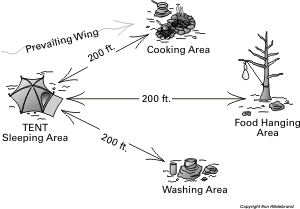
Figure 6. 26
General Bear Bagging Tips:
“Bear bagging” is something of a general term used for hanging your food. There are lots of other animals (raccoons, opossums, coyotes, chipmunks, skunks, etc.) that will go after human food. In some cases you may be camped in locations where there are no bears, but still need to hang your food at night. The best thing to do is talk with local rangers about what the “critter” population is and what precautions you will need to take. In areas with significant bear problems, there may be permanent food hanging stands or containers provided by the park.
Hang up all food (except unopened canned food), pots, pans, cups, bowls, utensils, all garbage. In grizzly bear territory you should also hang up used tampons (see Chapter 5 - Leave No Trace Camping: Women and Menstruation; Chapter 7 - Natural History: Dealing with Bears). On one backpacking trip in Shenandoah National Park, we diligently hung everything up. Around midnight a black bear came into camp and trotted off with someone’s pack. He had left a tube of toothpaste in one of the outer pockets (perhaps because of their breath problems, bears love toothpaste). Be sure that your camp is clean of food scraps which may attract a bear. Suspend food and garbage in duffel bags, stuff sacks, or sealed plastic bags at least 12-15 feet (3.6 - 4.5 meters) above the ground and at least 8 feet (2.4 meters) from the tree trunk. The bags should hang from a point where the tree can still support them but bear cubs and other critters will have difficulty reaching them. Make sure the bags cannot be reached from the ground, either.
Be creative and sensible with your techniques of hanging food. A 75 foot (23 meters) rope (at least ¼ inch thick - 6 millimeters), two carabiners, and stuff sacks are helpful. When using stuff sacks, don’t hang the sack directly from the drawstring. Instead, wrap the string around the neck of the sack and tie it leaving a loop through which to clip a carabiner. This technique alleviates the stress on the drawcord by distributing the stress to the entire sack. Thus, the stuff sack is less likely to rip and spill its contents onto the ground. Below are two useful methods of bear bagging:
Counterbalance Method (see Figure 6.27):
- Find a tree with a live branch. The branch should be at least 15 feet (5 meters) from the ground with no object below the branch that could support a bear’s weight. The point at which you will toss the rope over the branch should be at least 10 feet (3 meters) from the tree. The branch should be a least 4 inches in diameter (10 centimeters) at the tree and at least 1 inch in diameter (3 centimeters) at the rope point.
- Separate your food and other items into two bags of roughly equal weight.
- Throw the rope over the branch. Attach one end of the rope to one of the bags.
- Raise the bag as high as you can up to the branch.
- Attach the other bag to the rope as high up on the rope as you can. Leave a loop of rope near the bag for retrieval.
- Push the second bag up to the level of the other bag with a long stick.
- To retrieve the bags, hook the loop of rope with the stick and pull it down. Remove the bag and then lower the first bag.
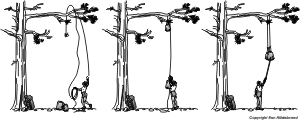
Figure 6.27
Marrison Haul System
This simple but effective mechanical advantage hauling system was developed by Chris Marrison for the Outdoor Action Program (see Figure 6.28). It's particularly helpful when you have heavy food loads. Bears are very intelligent and some bears are smart enough to know that by cutting the diagonal rope to the tree, they can bring down the food bag.
- Find a tree with a live branch. The branch should be at least 15 feet (5 meters) from the ground with no object below the branch that could support a bear’s weight. The point at which you will toss the rope over the branch should be at least 10 feet (3 meters) from the tree. The branch should be a least 4 inches in diameter (10 centimeters) at the tree and at least 1 inch in diameter (3 centimeters) at the rope point.
- Throw the rope over the branch. Test the branch to make sure it is strong enough to hold the weight (don't be standing directly underneath when you test). Make a Truckers Hitch about 6 feet (2 meters) from the ground and clip carabiner 1 into the bight.
- Feed the running end of Rope End B through Carabiner 2 and then through Carabiner 1.
- Pull the end of the Rope End A to move Carabiner 1 as close to the tree branch as possible. Tie off Rope End A to the tree.
- Attach the food bag to Carabiner 2 and haul the bag as high up as possible. Tie off Rope End B.
- To retrieve the bag, untie Rope End B and lower the bag to the ground.
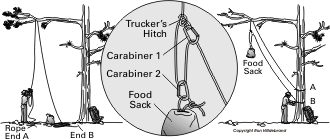
Figure 6.28
Helpful Hauling Hints:
- Use a sturdy tree as a block around which to pull the rope. Protect the bark from friction in the rope by using a stuff sack or piece of clothing.
- Find a sturdy, dead branch on the ground and tie the end of the rope to be pulled to this branch. The branch serves as a yoke and allows more than one person to efficiently pull on the rope at once.
If the Area is Treeless:
If you are going to be traveling in a treeless area where bears are present
you will need to take additional precautions. You may want to invest in bearproof
plastic containers to store your food in and leave this on the ground away from
your Sleeping Area and Cooking Area (see Figure 6.26). Bears may still be able
to smell the food, but they cannot open the containers. Some parks provide bear
containers or bear poles. A bear pole is a pole with a Y-shaped top. Using a
large lifting pole with a hook on the end you can place your bags up in the
fork of the Y.
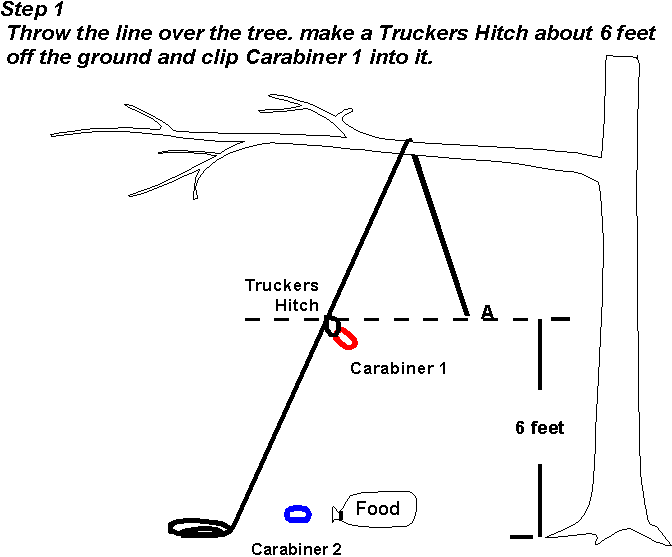 |
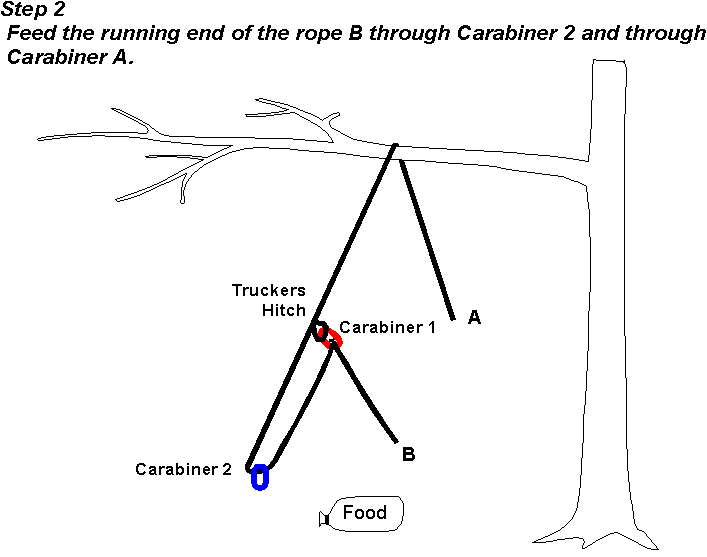 |
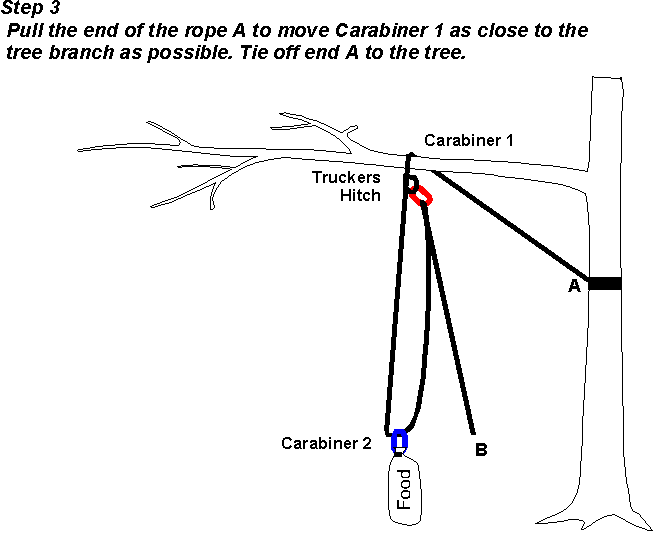 |
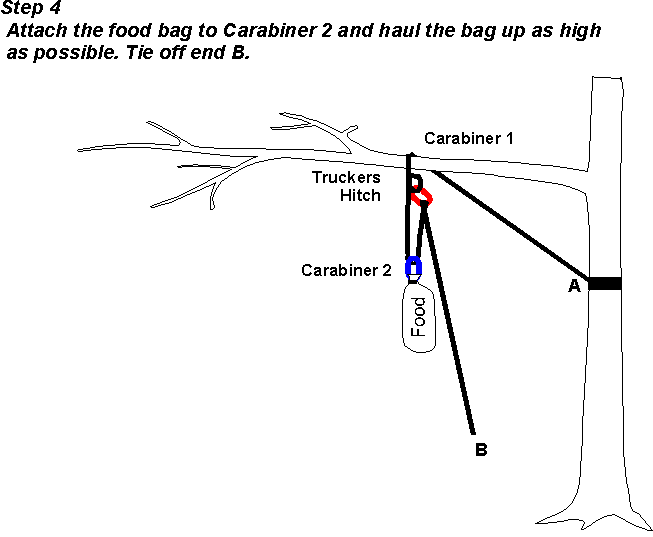 |

